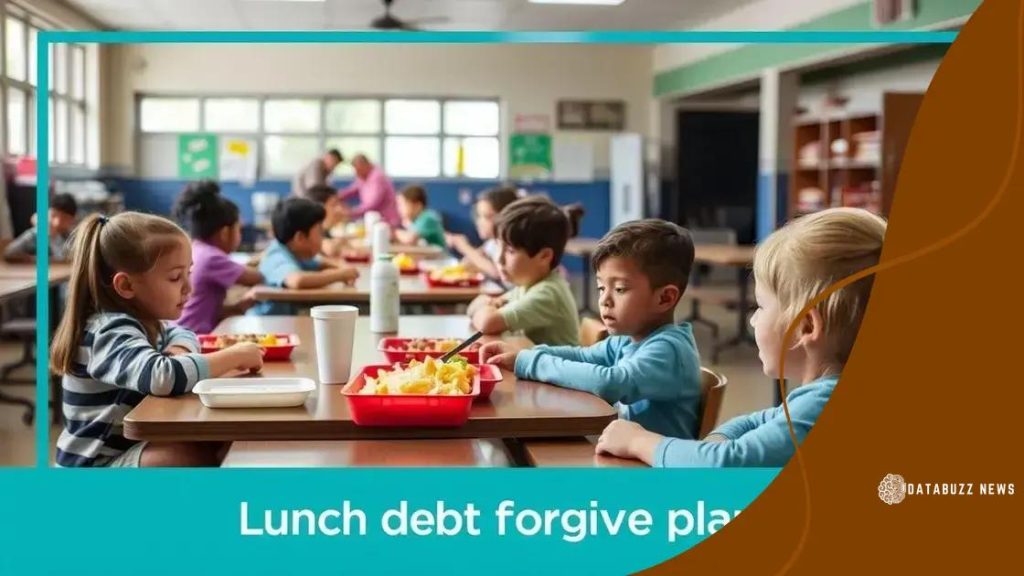Forgiveness plans for school lunch debt: a vital solution

Forgiveness plans for school lunch debt involve community fundraising, local business partnerships, and inclusive policies that ensure all students have access to nutritious meals without the stigma of unpaid balances.
Forgiveness plans for school lunch debt are becoming essential as schools seek to provide every child with access to healthy meals. Have you ever wondered how this affects students and families?
Understanding school lunch debt
Understanding school lunch debt is crucial for grasping the challenges many students face today. This issue affects not only the children but their families and the schools as well. Many students go to school without the ability to pay for lunch, leading to accumulated debts that can impact their access to meals.
Students who accumulate lunch debt may face various consequences, which can be discouraging. Some schools implement strict policies where students with outstanding balances cannot receive a regular lunch. This can lead to issues like feelings of shame or exclusion among those students, which impacts their overall well-being and ability to focus on learning.
The consequences of lunch debt
The effects of lunch debt extend beyond just missing meals. Here are some consequences:
- Stigmatization: Students may feel embarrassed when singled out for owing money.
- Nutrition: Skipping meals can lead to health problems and poor academic performance.
- Disruption: Schools may face administrative burdens managing lunch debts.
Understanding why school lunch debt occurs is just as important. Various factors contribute to this issue including economic disparities and lack of funding. Many families struggle financially, and unexpected expenses can lead to missed payments for school lunches. Such debts often accumulate before parents realize there’s a problem.
Addressing the issue
Schools and communities are looking for solutions to alleviate lunch debt. Programs that raise funds to pay off these debts can make a significant difference. It’s essential for parents and schools to collaborate on managing lunch resources. Creating awareness about available support can reduce the stigma associated with debt.
Moreover, community involvement has proven effective in addressing this issue. Local businesses and organizations can support schools by funding meal programs. They can also advocate for policy changes that provide better funding for school nutrition.
The impact of lunch debt on students
The impact of lunch debt on students is a growing concern in many schools. When children build up lunch debt, it affects not only their meals but their overall school experience. Many children are embarrassed to reveal their lunch balances, leading to feelings of shame and exclusion.
Some students may receive alternate meals if they have outstanding debts, which often consist of less appealing options. This can discourage them from eating, hindering their nutritional intake. Moreover, children who face these situations may struggle academically, as hunger can distract them from learning.
Emotional Effects
The emotional toll on students dealing with lunch debt is significant. Feelings of anxiety and stress can arise from being singled out due to unpaid lunch fees. Peer interactions can also suffer; classmates may notice the difference in meals and treat the affected students differently, creating a social divide.
Furthermore, the lack of a healthy meal can lead to health issues down the line. When students cannot access balanced lunches, they miss out on essential nutrients important for growth and concentration. This can contribute to long-term health problems and hinder academic performance.
Long-Term Consequences
Beyond the immediate concern of missing meals, there are potential long-term consequences associated with lunch debt. Students may develop negative attitudes toward school meals and even school in general. If the issue persists, it can lead to chronic issues with food insecurity later in life.
Understanding the impact of lunch debt on students is crucial for schools and communities alike. By acknowledging these challenges, we can work towards solutions that ensure all students have equal access to nutrition and a positive school experience.
Strategies for implementing forgiveness plans

Implementing forgiveness plans for school lunch debt requires thoughtful strategies to ensure success. These plans not only help students but also support families and communities struggling with food insecurity. By using effective methods, schools can ease the burden of lunch debt while promoting a supportive environment.
One of the first steps is to create awareness about the issues surrounding lunch debt. Schools can hold informational sessions for parents, explaining the importance of lunch programs and the impact of unpaid debts. Understanding the importance of nutrition in a child’s education fosters community involvement.
Developing Support Networks
Building partnerships with local organizations is another effective strategy. Schools can collaborate with charities, food banks, and businesses to create a support network for families in need. This network can provide financial resources or food donations. The more community members involved, the stronger the support system becomes for students facing debt.
- Organize fundraising events to help clear debts.
- Engage local businesses to sponsor meals.
- Connect with nonprofits focused on food security.
Another approach is to implement a sliding scale for lunch fees. By adjusting costs based on family income, schools can reduce the chances of accruing lunch debt. This method ensures that all students can enjoy a healthy meal while easing financial strain on families. Regular assessments can ensure the program meets the needs of students and families.
Creating Positive Policies
Schools can also revise policies around lunch debt to make them more compassionate. Instead of holding students accountable for debt, policies can focus on providing meals without stigma. This promotes a nurturing environment where students are encouraged to learn, not worried about unpaid balances.
Engaging students in the conversation by asking for their input can help refine these strategies. When students feel their voices are heard, they can contribute valuable insights on what changes would work best for them.
Successful case studies of lunch debt forgiveness
Successful case studies of lunch debt forgiveness provide valuable insights into how schools can address this pressing issue. By analyzing effective programs, other schools can learn how to implement similar strategies. These examples highlight the importance of community involvement and innovative approaches.
One notable case is that of a school district in California that established a community fund to assist families with lunch debt. The initiative raised funds through local businesses and donations, allowing students to receive meals without the burden of unpaid balances. This program not only cleared existing debts but also prevented future debts from accumulating.
Collaboration with Local Organizations
Another inspiring example comes from a district in Texas that partnered with a nonprofit organization. This organization provided additional resources to ensure all students received free meals. By simplifying the application process, many more families in need were able to take advantage of the program.
- Local volunteers helped raise awareness about the importance of lunch programs.
- School staff received training on how to identify families in need.
- Community events showcased the benefits of supporting school meal programs.
In Illinois, a school district implemented a remarkable policy where any accumulated lunch debt was forgiven at the end of each school year. This approach relieved the stress on students and their families, allowing them to focus on education instead of financial challenges. This policy led to increased participation in school meal programs, as students no longer feared debt consequences.
Impact on Student Well-Being
These successful cases have shown that forgiving lunch debt leads to a positive school environment. Students who feel secure about their meals are more likely to thrive academically. Positive mental health is often linked to proper nutrition, making this an essential aspect of learning.
Additionally, community members often feel proud of their contributions when they see tangible results. The collaboration between schools and local entities fosters a stronger sense of community. Ultimately, these case studies prove that with creativity and commitment, lunch debt forgiveness can become a reality for many students.
How communities can support these initiatives
Communities play a vital role in supporting initiatives related to lunch debt forgiveness for students. By coming together, they can create a safety net for families in need. There are various ways local organizations, businesses, and citizens can get involved and make a difference.
One effective strategy is to establish community fundraising events. These events can raise money specifically aimed at relieving lunch debt. Ideas might include bake sales, car washes, or local concerts, where the proceeds go directly to supporting school meal programs.
Engaging Local Businesses
Local businesses have an opportunity to participate in these initiatives through sponsorships. By partnering with schools, businesses can offset the costs of meals for students. Offering discounts or donations for school supplies can also ease the financial burden on families.
- Business employees can volunteer at school events.
- Develop programs that match donations for every meal purchased.
- Run promotions where a percentage of sales goes to clearing lunch debt.
Another critical aspect of community support is raising awareness about the challenges families face regarding lunch debt. Hosting informational sessions at community centers or libraries can inform citizens about how they can help. These gatherings can also provide resources for families who need assistance navigating lunch programs.
Building Strong Partnerships
Collaborations with local food banks and nonprofits can enhance the impact of community efforts. These organizations often have established networks that can streamline the process of providing meals to students in need. By joining forces, communities can ensure that no child goes hungry.
Schools can also encourage students to participate in service-learning projects that give back to their community. Such initiatives help raise awareness among youth about the importance of nutrition and the challenges their peers face. This not only fosters empathy but also promotes a sense of responsibility.
FAQ – Frequently Asked Questions about School Lunch Debt Forgiveness
What is lunch debt?
Lunch debt occurs when students cannot pay for their school meals, leading to outstanding balances owed by families.
How can communities help reduce lunch debt?
Communities can organize fundraising events, partner with local businesses, and create awareness about the issue to support forgiveness initiatives.
What impact does lunch debt have on students?
Lunch debt can cause students to feel embarrassed and anxious, affecting their well-being and ability to focus on their studies.
Are there successful examples of lunch debt forgiveness?
Yes, some school districts have implemented community funds and partnerships to successfully forgive lunch debt and provide free meals.
